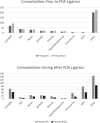A comparison of postoperative outcomes with PDA ligation in the OR versus the NICU: a retrospective cohort study on the risks of transport
- PMID: 30579349
- PMCID: PMC6303951
- DOI: 10.1186/s12871-018-0658-6
A comparison of postoperative outcomes with PDA ligation in the OR versus the NICU: a retrospective cohort study on the risks of transport
Abstract
Background: Although patent ductus arteriosus (PDA) ligations in the Neonatal Intensive Care Unit (NICU) have been an accepted practice, many are still performed in the Operating Room (OR). Whether avoiding transport leads to improved perioperative outcomes is unclear. Here we aimed to determine whether PDA ligations in the NICU corresponded to higher risk of surgical site infection or mortality and if transport was associated with worsened perioperative outcomes.
Methods: We performed a retrospective cohort study of NICU patients, ≤37 weeks post-menstrual age, undergoing surgical PDA ligation in the NICU or OR. We excluded any infants undergoing device PDA closure. We measured the incidence of perioperative hypothermia, cardiac arrest, decreases in SpO2, hemodynamic instability and postoperative surgical site infection, sepsis and mortality.
Results: Data was collected on 189 infants (100 OR, 89 NICU). After controlling for number of preoperative comorbidities, weight at time of procedure, procedure location and hospital in the mixed-effect model, no significant difference in mortality or sepsis was found (odds ratio 0.31, 95%CI 0.07, 1.30; p = 0.107, and odds ratio 0.40; 95%CI 0.14, 1.09; p = 0.072, respectively). There was an increased incidence of hemodynamic instability on transport postoperatively in the OR group (12.4% vs 2%, odds ratio 6.93; 95% CI 1.48, 35.52; p = 0.014).
Conclusion: PDA ligations in the NICU were not associated with higher incidences of surgical site infection or mortality. There was an increased incidence of hemodynamic instability in the OR group on transport back to the NICU. Larger multicenter studies following long-term outcomes are needed to evaluate the safety of performing all PDA ligations in the NICU.
Keywords: Neonatal intensive care unit; Newborn infant; Patent ductus arteriosus; Postoperative period Hemodynamics.; Surgical wound infection.
Conflict of interest statement
Ethics approval and consent to participate
IRB approval was obtained from each institution. IRB#15–000092-CR-00001 (UCLA webIRB) was approved on February 12, 2015 and IRB #5150084 (Loma Linda University Institutional Review Board) was approved on March 20, 2015. Both received waiver of requirement for HIPAA Research Authorization and waiver of requirement for informed consent for entire study.
Consent for publication
Not Applicable
Competing interests
The authors declare that they have no competing interests.
Publisher’s Note
Springer Nature remains neutral with regard to jurisdictional claims in published maps and institutional affiliations.
Figures



